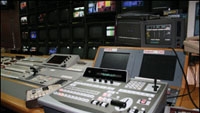FOR-A's HVS-500HS
While the luckiest rugby football fans were at the stadium cheering on their country to win the 6 Nations rugby match, the next luckiest were viewing the event in HD provided by the BBC's HD test channel. Of course, the rest of the fans watched on SD.

For this live simulcast, the BBC sports department was aware that the HD transmission should benefit from the same aspects of presentation as those of SD. This way, it could take full advantage of the increased resolution and freedom from having to present graphics to suit the older 4:3 SD screens. So the HD program output, rather than simply being a bigger picture version of the SD, was supplied with its own presentation. This included its own mixing between the OB and studio outputs, as well as allowing for the independent presentation of graphics that would better suit the HD image size and an audience looking at only 16:9 screens.
At least one match per week from the competition was presented in HD. Working in BBC Studios' Studio 5, the HD operation ran in parallel with that of the SD. The HD requirement involved putting original SD graphics over the top of the HD coverage coming from the OB truck.
It also required the ability to link the scenes at halftime as well as those before and after the match, just as though it was the SD program. This entailed providing the full sports coverage from the opening titles through to the end credits in HD, albeit with some of those components originating in SD and needing upconversion.
This approach was not possible using the HD broadcast presentation/transmission area that fed the HD test channel. This was because although it can perform cut transitions for going on-air, it could not provide the presentation elements that the sports department wanted — mixing and keying the graphics.
The switcher
The BBC selected FOR-A's HVS-500HS, a one M/E switcher, to provide the function of a small presentation switcher in parallel with the main SD paths. The unit is HD/SD-switchable and is an all-in-one package. The processing and all connections, including from four to 12 inputs and up to seven outputs (digital and analog), are all mounted on the underside of the control panel.
We wanted it up on a production surface, so there was a limit as to how big it could be. The small size allowed it to be located in the optimum position, next to the main studio SD switcher.
Although the switcher is designed to be basic, it includes a few extras such as a downstream keyer with chroma key that is assignable to PGM, AUX, 1, 2 or 3. There are also two still stores, a multitude of wipe and dissolve patterns, graded backgrounds, two channels of picture-in-picture, and process control to adjust input levels.
One of the aims of the switcher is to keep the price low by ensuring customers pay only for the capabilities they want, and avoiding having to pay for unwanted parts that are unavoidably supplied as standard. This means it has a lengthy list of plug-in options. However, the only one required for the 6 Nations project was the addition of a second keyer.
Switching for 6 Nations
For the 6 Nations coverage, the HD presentation took in the incoming HD feed from the OB and routed it onto the switcher. Also, the SD studio output was upconverted. In addition, there were two graphics feeds — one key and one fill — that were upconverted. Thus, the switcher had four HD inputs: the OB, the studio, key and fill. This allowed the keying of graphics in HD over the top of the OB or studio, or mixing between studio and OB, or going clean to the OB.
The HVS-500HS is a simple switcher that performs a simple task in a one-box solution. It is ideal for small-scale operations, especially where larger and more complex facilities are not needed. As a result, unnecessary costs and possible complications are avoided.
Danny Popkin is technical development manager for Studios at BBC Resources.
Get the TV Tech Newsletter
The professional video industry's #1 source for news, trends and product and tech information. Sign up below.
